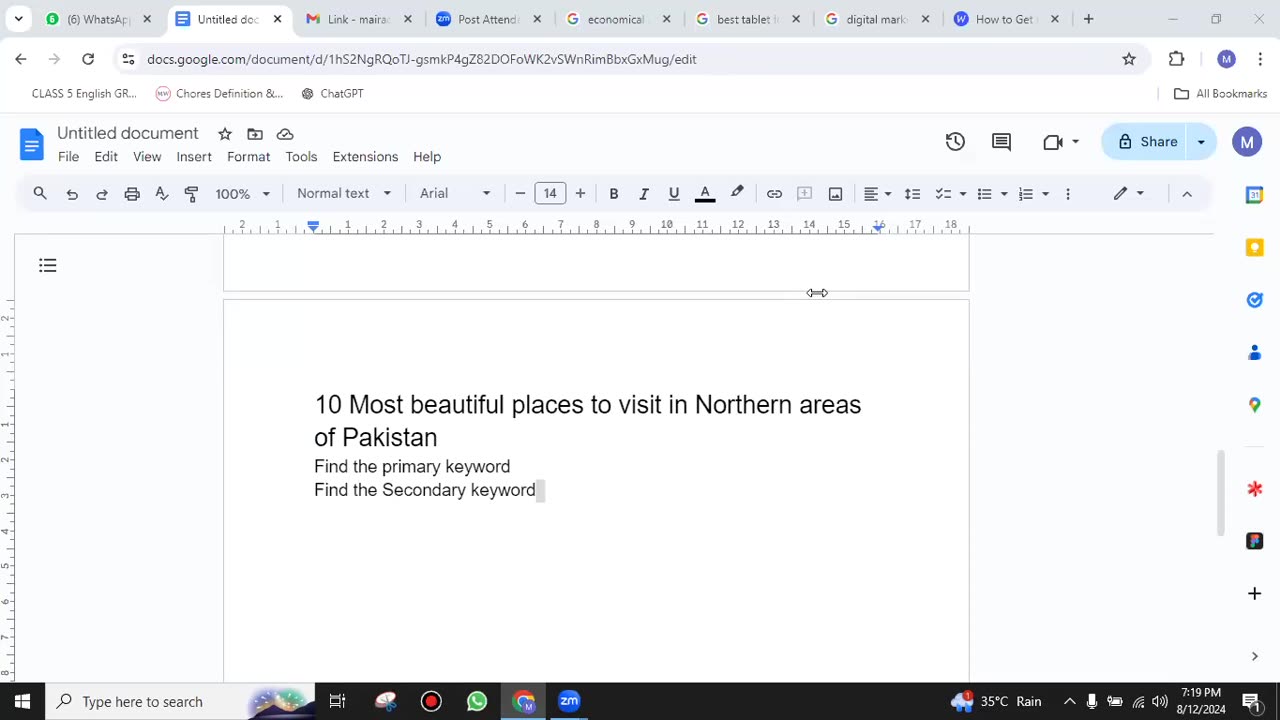Premium Only Content

Lect#4 SEO Content Writing By Miss Maira Qureshi #LWE Batch#103-104
Keyword research is a crucial step in SEO that involves identifying and analyzing the search terms that people use when looking for information, products, or services online. Here’s a breakdown of the process and some best practices:
### Steps for Effective Keyword Research
1. **Identify Your Goals**:
- Define what you want to achieve (e.g., increased traffic, lead generation, sales).
- Understand your target audience and their needs.
2. **Brainstorm Seed Keywords**:
- Start with broad topics relevant to your business or niche.
- Think of words or phrases your audience might use.
3. **Use Keyword Research Tools**:
- Utilize tools like:
- **Google Keyword Planner**: Offers keyword suggestions and search volume.
- **Ahrefs**: Provides keyword ideas, difficulty scores, and search volume.
- **SEMrush**: Offers a comprehensive keyword database and competitive analysis.
- **Ubersuggest**: A user-friendly tool for finding keyword ideas.
- **Answer the Public**: Generates questions and phrases based on a keyword.
4. **Analyze Keywords**:
- **Search Volume**: Look for keywords that have a substantial number of searches.
- **Keyword Difficulty**: Assess how competitive a keyword is. Lower difficulty scores are usually better for new sites.
- **Relevance**: Ensure the keywords align with your content and audience intent.
5. **Consider User Intent**:
- Determine the intent behind the searches:
- **Informational**: Users seeking information (e.g., "how to cook pasta").
- **Navigational**: Users looking for a specific website (e.g., "Facebook login").
- **Transactional**: Users intending to make a purchase (e.g., "buy running shoes").
6. **Long-Tail Keywords**:
- Focus on longer, more specific phrases (e.g., "best running shoes for flat feet") as they often have lower competition and higher conversion rates.
7. **Competitive Analysis**:
- Analyze the keywords your competitors are ranking for using tools like Ahrefs or SEMrush. Identify gaps and opportunities.
8. **Organize Your Keywords**:
- Create a spreadsheet to categorize keywords by topic, search volume, difficulty, and intent. This helps in planning content and optimizing existing pages.
9. **Monitor and Adjust**:
- After implementing your keywords, regularly track their performance. Use tools like Google Analytics and Search Console to measure traffic and engagement.
### Best Practices
- **Focus on Relevance**: Always prioritize keywords that are relevant to your content and audience.
- **Diversify Your Keywords**: Use a mix of head terms (broad keywords) and long-tail keywords to cover different aspects of your niche.
- **Optimize Content Accordingly**: Integrate your keywords naturally into titles, headings, meta descriptions, and throughout the content without keyword stuffing.
- **Stay Updated**: Keyword trends can change, so regularly revisit and update your keyword strategy based on performance and shifts in user behavior.
By following these steps and best practices, you can develop a robust keyword strategy that enhances your SEO efforts and drives targeted traffic to your website.
-
 LIVE
LIVE
Dr. Drew
5 hours agoLuke Rudkowski: Epstein List Release Fail, Zelenskyy's White House Tantrum & Corruption In Congress – Ask Dr. Drew
1,509 watching -
 1:05:46
1:05:46
Candace Show Podcast
5 hours agoHarvey Speaks: Shocking Emails Revealed | Ep 2
28.5K9 -
 LIVE
LIVE
Michael Franzese
2 hours agoRFK Was Right… But It’s Worse Than You Think | Jillian Michaels
1,664 watching -
 1:23:47
1:23:47
Redacted News
2 hours agoEPSTEIN BOMBSHELL! SOMETHING VERY STRANGE IS GOING ON HERE, WHO ARE THEY PROTECTING? | REDACTED LIVE
77.7K104 -
 1:05:37
1:05:37
Sean Unpaved
4 hours ago $2.18 earnedUnpaved
26.7K4 -
 56:40
56:40
VSiNLive
2 hours ago $1.55 earnedFollow the Money with Mitch Moss & Pauly Howard | Hour 1
21.7K3 -
 1:00:52
1:00:52
In The Litter Box w/ Jewels & Catturd
23 hours agoFIRST 40 DAYS | In the Litter Box w/ Jewels & Catturd – Ep. 754 – 3/4/2025
64.2K34 -
 1:20:04
1:20:04
Awaken With JP
6 hours agoHow Impressive is Zelensky? - LIES Ep 81
75.5K40 -
 2:14:02
2:14:02
The Quartering
6 hours agoEpstein Files FINALLY Arrive, Zelensky CRAWLS Back & Trump Cuts Off, Oscars Sink To New Low & More
96.4K44 -
 57:11
57:11
Russell Brand
4 hours agoBREAK BREAD EP. 16 - SEAN FEUCHT
86.4K5